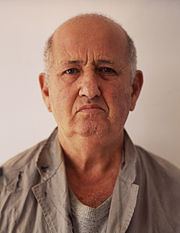- Moshe Gershuni
-
Moshe Gershuni 
Photograph of Moshe Gershuni, 2007Born 1936 (age 74–75)
Tel Aviv, IsraelNationality Israeli Field Painting Training Avni Institute of Art and Design, Tel Aviv Movement Israeli art Moshe Gershuni (born 1936) is an Israeli painter.
Contents
Early life
Moshe Gershuni was born in 1936 in Tel Aviv in the British Mandate of Palestine. His parents Yona and Zvi Kutner immigrated there from Poland in the 1920s. He spent his childhood in Tel Aviv and graduated from the local religious high school in 1954. He has two siblings; a brother named Avshalom and a sister named Mira. From 1960 to 1964 he studied at the Avni Institute of Art and Design, an Israeli art school located in Tel Aviv.[1] Moshe Gershuni was one of the first artists in Israel to explore highly modernistic, iconoclastic possibilities, at the end of the 1960s creating works which were paradigms of Conceptual art, and in the 1970s extending his art to public performance. As a stimulating teacher in Bezalel, he fueled the imagination of many young artists, especially towards political involvement. At the Venice Biennale in 1980, Gershuni showed paintings on paper in red lacquer, amidst canals of blood, creating an atmosphere of Holocaust. Immediately afterwards he began a period of painting which stands out as a milestone in Israeli art. Using free scrawl, drip, finger paint and calligraphy, he suggests personal, Zionist, Moslem and Christian symbols. These works seem to have been created in a trance. His recent silk screens ("Kaddish") are among the finest produced in the country in recent years.
Education
- 1960-1964 Avni Institute of Art and Design, Tel Aviv
Teaching
- 1972-77 Bezalel Academy of Art and Design, Jerusalem
- 1978 Art Teachers College, Ramat Hasharon
Awards and Prizes
- Aika Brown Prize, Israel Museum, 1969
- Sandberg Prize for an Israeli Artist, Israel Museum, 1982
- Minister of Education and Culture Prize for a Young Artist, 1988
- Kolb Prize, Tel Aviv Museum, 1989
- Sussman Prize, Yad Vashem, 1995
- Mendel and Eva Pondik Prize, Tel Aviv Museum
- George and Janet Jaffin Prize Since America-Israel Cultural Foundation, 2000
Career
After graduating in 1964 from the Avni Institute of Art and Design he worked as a professor at various art schools. From 1972 to 1977 he worked as a professor at the Bezalel Academy of Arts and Design, Israel's national school of art. From 1978 to 1986 he taught at the Art Teachers Training College, in Ramat HaSharon.[1]
Articles
- THE JERUSALEM POST - BILLBOARD, 24.09.2010
- THE JERUSALEM REPORT 13.01.2011
External links
- "Moshe Gershuni collection". Israel Museum. http://www.imj.org.il/imagine/collections/results-free.asp?searchType=simple&words2=Moshe+Gershuni&Submit=Search. Retrieved August 14, 2011.
- "Moshe Gershuni". Information Center for Israeli Art. Israel Museum. http://www.imj.org.il/artcenter/default.asp?artist=272993. Retrieved August 14, 2011.
- "Moshe Gershuni". Europeana. http://www.europeana.eu/portal/search.html?query=Moshe+Gershuni. Retrieved August 14, 2011.
References
- ^ a b "Biography of Moshe Gershuni". C. Moss Gallery. http://www.tobeycmossgallery.com/Gershuni_bio.html. Retrieved August 14, 2011.
Categories:- Israeli artists
- 1936 births
- Israeli painters
- Living people
- Israeli artist stubs
Wikimedia Foundation. 2010.
